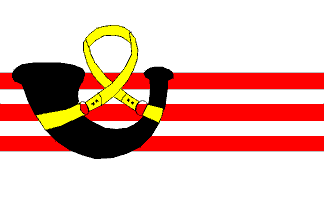![[Tietjerksteradeel flag]](../images/n/nl-fr-tj.gif) by Jarig Bakker, 5 May 2004
by Jarig Bakker, 5 May 2004
Adopted 22 Nov 1984; granted by Royal Resolution 11 Jul 1985. Design: Mr. G.D. Bontekoe.

Last modified: 2004-05-15 by jarig bakker
Keywords: tytsjerksteradiel |
Links: FOTW homepage |
search |
disclaimer and copyright |
write us |
mirrors
![[Tietjerksteradeel flag]](../images/n/nl-fr-tj.gif) by Jarig Bakker, 5 May 2004
by Jarig Bakker, 5 May 2004
Adopted 22 Nov 1984; granted by Royal Resolution 11 Jul 1985. Design:
Mr. G.D. Bontekoe.
The village flags and CoAs of this municipality have been scanned by
me from 'Doarpswapens en doarpsflaggen fan de doarpen yn de gemeente
Tytsjerksteradiel', - Village CoAs and village flags in the municipality
of Tytsjerksteradiel, edited by the municipality, Burgum, 1996. They have
been giffed by Gerard van der Vaart.
In 1977 there was a corso with decorated carts in the 7 villages of
the 'Trynwâlden-quarter' of the municipality (= three forests).
For those villages 7 flags and CoAs were designed. Later on there were
deliberations between the 'Fryske Rie foar de Heraldyk' (Frisian
Heraldic Council), the village local councils and the municipal Cultural
Council, by which in 1986 16 village flags and CoAs were adopted.
A note on the language: In Dongeradeel the official language is still
Dutch, while Frisian is accepted as second language. In Tytsjerksteradiel
(Dutch: Tietjerksteradeel) the official language seems to be Frisian; hence
I use the Frisian village names here.
Jarig Bakker, 5 November 2000
![[Tytsjerksteradiel CoA]](../images/n/nl-fr)tj.gif) by Jarig Bakker, 8 May 2003
by Jarig Bakker, 8 May 2003
Description: Quartered: I. in red in saltire a dipping-net and a scythe of silver; II. in silver a reedplant of three plumes on soil, all of green; III. in silver three planted trees of green; IV. in blue a hunting horn of gold. The shield surmounted by a golden crown of three leaves and two times three pearls.
The municipal arms of Tytsjerksteradiel consists of four divisional
arms:
I. (top left) the Tytsjerkster quarter, consisting of the villages
Tytsjerk, Ryptsjerk
and Suwâld.
II. (top right) with the three reedplumes is the Sumarder quarter,
with the villages Sumar, Eastermar
and Jistrum.
III. (bottom left) the Trynwâldster quarter, with the villages
Oentsjerk, Âldtsjerk,
Gytsjerk (and Mûnein).
IV. (bottom right) the Burgumer quarter, with the villages Burgum
(Noardburgum), Garyp
and Hurdegaryp.
Two villages are not represented in the municipal arms: Wyns
and Earnewâld.
Source: 'Doarpswapens en doarpsflaggen fan de doarpen yn de gemeente
Tytsjerksteradiel'
Jarig Bakker, 8 May 2003
![[Tytsjerksteradiel wimpel]](../images/n/nl-frwtj.gif) by Jarig Bakker, 19 Aug 2003
by Jarig Bakker, 19 Aug 2003
All Frisian municipalities have the right to use wimpels for festive
occasions, long bi-colored flags with in the hoist a characteristic element
of the municipal flag or CoA.
The description of the wimpel of Tytsjersteradiel is: two equally wide
stripes of red and white with a square blue hoist in which a yellow stringed
hunting horn.
Design: K. Bultsma
Adoption date: unknown
Source: typewritten letter of Mr. Bultsma.
Jarig Bakker, 19 Aug 2003
 by Jarig Bakker, 5 May 2004
by Jarig Bakker, 5 May 2004
On 6 July 1956 a flag was adopted, consisting of three equally wide
horizontal bars; the first and third bar white, the middle bar divided
in five equally wide stripes in 3 red and 2 white stripes and toward the
hoist a black horn with yellow inlay and cord.
This flag was in use until 1984.
Jarig Bakker, 2 Dec 1999